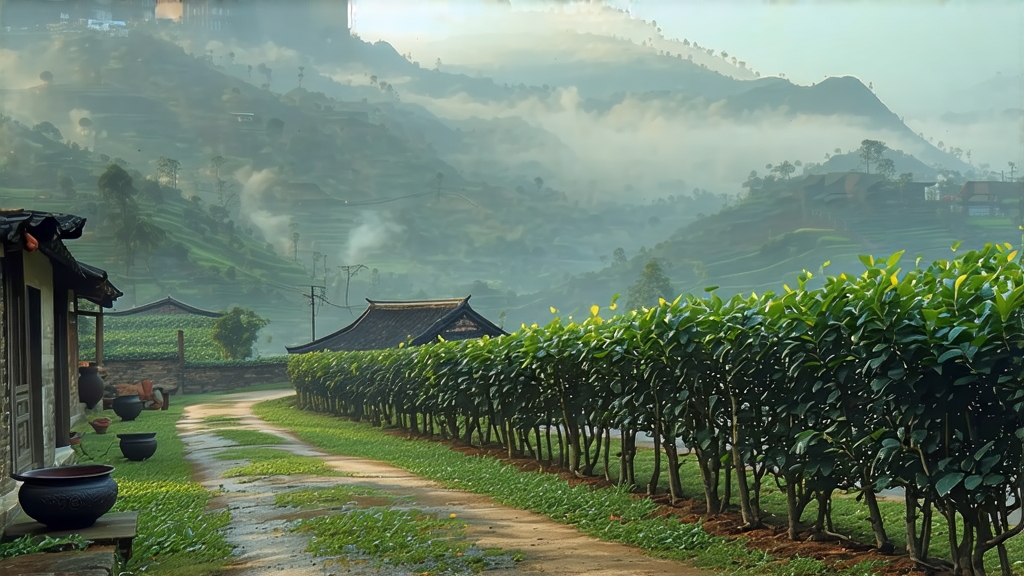
Tucked away in the humid, karst-pitted mountains of southern China’s Guangxi Zhuang Autonomous Region, Liu Bao tea has spent four centuries quietly fermenting its way into the hearts of Cantonese merchants, Southeast Asian miners, and, more recently, global dark-tea aficionados. While Pu-erh grabs headlines, Liu Bao remains the sleeper hit of the Hei Cha (dark tea) family: a leaf that tastes of damp earth, dried longan, and the camphor-lined storerooms where it once waited to sail down the Xun River to Hong Kong and then on to Kuala Lumpur’s tin-rich valleys. To understand Liu Bao is to follow the aroma of history, humidity, and human ingenuity.
Historical Footprints
The name Liu Bao literally means “six forts,” a reference to the six stockades that once guarded the small basin where the tea was first compressed into baskets in the Qing dynasty. By the late 1600s, itinerant Yao and Han tea makers discovered that the broad-leaf Camellia sinensis var. assamica growing above 300 m elevation developed a mellow sweetness after prolonged raft journeys downriver. The humid holds of bamboo-raft boats acted as mobile fermentation labs, softening the leaf and darkening its liquor. Traders in Guangzhou’s Thirteen Factories noticed the tea matured en route and began ordering it intentionally aged, giving birth to the earliest documented “wet storage” program—centuries before the concept existed in wine.
When Cantonese migrants flocked to British-run tin mines in Malaya in the 1850s, they brought with them a taste for Liu Bao’s digestive warmth; the tea became a currency in mining camps, valued for preventing malaria-induced chills and cutting through the grease of coconut-laden diets. Ship manifests from 1907 list Liu Bao alongside opium and dried shark fin, proof of its status as a luxury commodity. After the Second World War, basket compression was standardized into 50 kg “big baskets” (da lou) and 5 kg “small baskets” (xiao lou), sizes still used today.
Micro-Terroirs and Leaf Styles
Guangxi’s subtropical monsoon climate delivers 1,600 mm of rain annually, shrouding the tea gardens in fog until late morning. The best gardens sit on weathered granite soils in Cangwu, Tengxian, and Lipu counties, where cool nights slow growth and thicken leaf cuticles. Unlike Yunnan’s ancient tea forests, Liu Bao gardens are tidy hedges of seed-propagated bushes 30–60 years old, intercropped with cinnamon and pomelo to deter pests and add subtle top-notes to the leaf.
Three traditional leaf grades are recognized:
• Special Grade (te ji): one bud with two leaves, picked before Qingming, yielding a bright, orchid-like fragrance after aging.
• First Grade (yi ji): one bud with three leaves, plucked before the Grain Rain, balanced between floral and earthy.
• Third Grade (san ji): four to five leaves, harvested through early summer, destined for long aging and robust minerality.
Crafting the Darkness
Liu Bao’s hallmark is “wet piling” (wo dui), a controlled post-fermentation that predates Pu-erh’s similar process by at least a century. Fresh leaf is pan-fired at 280 °C for three minutes to kill green enzymes, then rolled for 25 minutes until strips break cell walls without losing fuzz. After a brief sun-wither, the leaf is piled 70 cm deep on bamboo mats and misted with mountain spring water until moisture reaches 35%. The pile is covered with jute sacks and left to heat spontaneously to 60 °C over the next ten days, turned every 48 hours to inject oxygen and prevent anaerobic sourness.
Once the core turns walnut-brown and emits a sweet, betel-nut scent, the tea is sun-dried again, then steamed for seven seconds and packed into cylindrical bamboo baskets lined with fresh banana leaves. The residual moisture continues a slow microbial fermentation fueled by Aspergillus niger, Blastobotrys adeninivorans, and a unique strain of Bacillus subtilis christened “GXLB-12” by researchers at Guangxi University. Over decades, these microbes convert catechins into theabrownins and gallic acid, softening astringency and creating the tea’s signature “ginseng throat” (rensheng yun)—a cooling, menthol-like finish that appears only after fifteen years